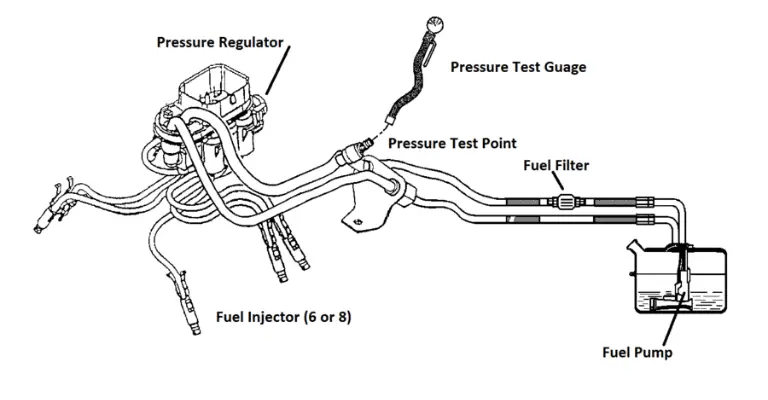It’s common knowledge that spiders can be a nuisance, but when it comes to your vehicle’s performance, a different kind of “spider” can cause even bigger problems.
We’re talking about Spider Injectors, an integral component of the fuel delivery system in certain engines. So, if you’re experiencing performance issues with your car, the culprit might be a bad spider injector.
But how do you know if it’s the spider fuel injector causing the trouble? Is it just dirty fuel injectors, or is it something else? Let’s delve into the symptoms, causes, and how to test for a malfunctioning spider injector. What’re you waiting for? Let’s get to it!
What Causes Issues with the Spider Injection System?
The Spider Injector, named for its distinct spider-like shape, is part of the Central Port Injection (CPI) or Central Sequential Fuel Injection (CSFI) systems used in some General Motors (GM) vehicles. These systems, the CPI and CSFI, are designed to deliver precise amounts of fuel to the engine’s cylinders.
Problems with the spider injection system are typically caused by:
- Wear and Tear: Over time, the spider fuel injectors can wear down due to the constant high pressure and temperature it’s exposed to, leading to leaks or blockages.
- Fuel Quality: Poor quality fuel can lead to deposit build-up, causing the injector poppets to stick close.
- Fuel Pressure Regulator: Known for causing leaks, a malfunctioning fuel pressure regulator can lead to fuel escaping into the intake manifold, causing a variety of performance issues.
Here’s a video detailing some of these problems in a real life setting:
[su_youtube_advanced url=”https://www.youtube.com/watch?v=321ECgg_qWk”]
What are the Symptoms of Bad Spider Injectors?
A faulty spider injector can manifest itself through various symptoms. Here are some common signs that your spider injector might need attention:
- Rough Idle: A malfunctioning spider fuel injector can cause the engine to idle roughly due to an imbalance in the air-fuel mixture.
- Misfire: The check engine light might come on due to misfire codes (usually a P0300: Random Misfire) and air/fuel mixture too Rich codes (P0172, P0175).
- Poor Fuel Economy: If you’re noticing that your vehicle is consuming more fuel than usual, it could be because of a leak in the spider injector.
- Hard Start or No-Start: Difficulty starting the vehicle, extended cranking time, or a complete failure to start can indicate a problem with the spider fuel injectors.
- Black Smoke: Black smoke emanating from the tailpipe is a sign of an overly rich fuel-air mixture, which could be caused by a leaking spider injector.
How to Test For Bad Spider Injectors
Before you start, bear in mind that you’ll need a fuel pressure gauge to troubleshoot the fuel injector assembly. Also, remember to prioritize safety when working with fuel.
- Conduct a Fuel Pressure Test: With the engine off, the pressure should build to around 60-66 psi. If it drops quickly after turning the key off, there’s a leak.
- Identify the Leak: Install a valve in the supply line and the return line. Pressurize the system, close the supply valve, and quickly turn the key off. If the pressure holds, the leak is upstream of the valve at the pump. If it drops, it’s either going back through the return (regulator) or an injector.
- Check the Regulator and Injectors: Repressurize, close the return valve, and quickly turn the key off. If the pressure drops, it’s an injector. If it holds, the regulator is the culprit.
If the spider fuel injector is indeed at fault, you may need to replace it. In some cases, if the vehicle has already received an injector cleaning, it’s recommended to replace the entire fuel injector assembly with a new one.
Here’s an example of typical test points on a spider injector:

Is it ok to drive with bad spider injectors?
Driving with bad spider fuel injectors is not advisable. The fuel-air imbalance can cause severe engine damage over time. Moreover, fuel leaks pose a serious safety hazard due to the risk of fire. It’s best to address the problem as soon as any symptoms are noticed.
Related Questions
How can I tell if my vehicle uses a Spider Injector?
Spider Injectors are used primarily in GM’s CPI and CSFI systems, found in some 4.3L, 5.0L, and 5.7L engines. If you’re unsure, refer to your vehicle’s manual or consult a professional mechanic.
Can a Spider Injector be repaired?
While some minor issues might be fixable, it’s generally recommended to replace a malfunctioning spider injector for the best results.
What’s the cost to replace a Spider Injector?
The cost can vary depending on your vehicle’s make and model, but on average, you can expect to pay between $300 and $600 for parts and labor.
Conclusion
When dealing with Spider Injectors, remember, prevention is always better than cure. Regular maintenance and use of high-quality fuel can go a long way in keeping your spider injector in good shape. But, if you do find yourself bitten by a bad spider injector, use the knowledge from this article to get back on the road safely and quickly.